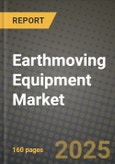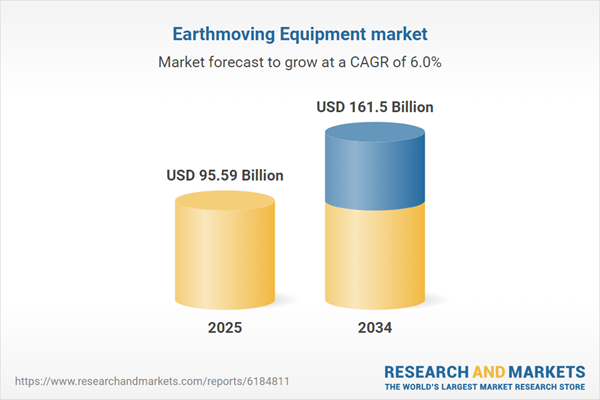Earthmoving Equipment market
The earthmoving equipment market encompasses machines that excavate, load, haul, grade, and compact soil and aggregates across building construction, roads and bridges, mining and quarrying, utilities, industrial sites, ports, agriculture/landscaping, and disaster recovery. Core categories include hydraulic excavators (mini to ultra-large), wheel and track loaders, bulldozers, motor graders, articulated/rigid dump trucks, backhoe loaders, skid-steer and compact track loaders, scrapers, and compactors. Technology roadmaps prioritize productivity per hour and cost per ton through electro-hydraulic efficiency, grade and payload automation, telematics-driven fleet optimization, and operator-assist features that compress training curves. Electrification and hybridization lead compact and mid-class introductions, while alternative fuels (HVO, natural gas, hydrogen ICE/fuel cell pilots) and idle-reduction strategies address decarbonization targets. Digital twins, 3D machine control, and cloud platforms integrate design models with field execution, reducing rework and material overruns. Procurement dynamics blend OEM direct sales with strong rental penetration; total cost of ownership - fuel/energy, planned service, resale value, and uptime guarantees - outweighs sticker price. Competitive intensity spans global OEMs, regional champions, Chinese value entrants, and specialist attachment makers; differentiation rests on duty-cycle match, dealer/service density, parts availability, and integrated site solutions (survey drones, site power, charging). Key challenges include skilled-operator shortages, jobsite power logistics for electrics, supply chain variability in hydraulics and semiconductors, and compliance with evolving emissions, safety, and noise regulations. Vendors that pair robust iron with open telematics, mixed-fleet interoperability, and lifecycle services - while helping contractors hit sustainability and reporting goals - are best positioned as infrastructure and industrial investment cycles continue.Earthmoving Equipment market Key Insights
- Compact equipment leads unit growth
- Automation narrows operator gap
- Telematics becomes a fleet OS
- Energy transition is pragmatic by class
- Hydraulics and driveline efficiency
- Rental as adoption flywheel
- Lifecycle value over list price
- Safety and visibility by design
- Data interoperability matters
- Emerging markets reshape competition
Earthmoving Equipment market Reginal Analysis
North America
Infrastructure renewal, energy/industrial projects, and housing support demand across excavators, loaders, and haul trucks. Strong rental penetration accelerates adoption of grade control and payload systems. Cold-weather packages, dealer service density, and HVO compatibility feature in specs; electrics gain in interior demo, utilities, and municipal work.Europe
Tight urban work zones, low-noise mandates, and stringent emissions rules push compact electrics and advanced automation. Public tenders value lifecycle carbon disclosures, safety tech, and digital reporting. Mixed-fleet telematics and CE compliance are table stakes; dealer networks emphasize uptime guarantees and remanufacturing.Asia-Pacific
Largest volume base with robust civil works, mining, and manufacturing. China and India drive high utilization of excavators, loaders, and ADTs; local brands compete on value and rapid parts supply. Premium segments in Japan, Korea, and Australia adopt 3D control, autonomous haul pilots, and high-efficiency hydraulics.Middle East & Africa
Mega-projects, mining, and logistics corridors sustain demand for heavy dozers, graders, and ADTs. Harsh-environment specs (dust sealing, cooling, filtration) and strong on-site service are decisive. Interest rises in hybrid/electric for tunnels/indoors; financing and parts availability drive awards.South & Central America
Mining, agrilogistics, and urban infrastructure underpin cyclical demand. Currency volatility and import costs favor durable mid-spec models, dealer financing, and robust aftermarket support. Telematics adoption grows to control fuel theft, plan maintenance, and document productivity for contractors and concessionaires.Earthmoving Equipment market Segmentation
By Product
- Dozer
- Excavator
- Loader
- Motor Grader
- Dump Truck
By Vehicle Weight
- < 10
- 11 to 45
- 46>
By Engine Capacity
- Up to 250 HP
- 250-500 HP
- More than 500 HP
By Type
- Wheel
- Crawler
By Drive Type
- ICE
- Electric
Key Market players
Caterpillar, Komatsu, Hitachi Construction Machinery, Volvo Construction Equipment, Deere & Company, JCB, XCMG, SANY Heavy Industry, Zoomlion, LiuGong, Hyundai Construction Equipment, HD Hyundai Infracore, Doosan Bobcat, CNH Industrial, Kobelco Construction MachineryEarthmoving Equipment Market Analytics
The report employs rigorous tools, including Porter’s Five Forces, value chain mapping, and scenario-based modelling, to assess supply-demand dynamics. Cross-sector influences from parent, derived, and substitute markets are evaluated to identify risks and opportunities. Trade and pricing analytics provide an up-to-date view of international flows, including leading exporters, importers, and regional price trends.Macroeconomic indicators, policy frameworks such as carbon pricing and energy security strategies, and evolving consumer behaviour are considered in forecasting scenarios. Recent deal flows, partnerships, and technology innovations are incorporated to assess their impact on future market performance.
Earthmoving Equipment Market Competitive Intelligence
The competitive landscape is mapped through proprietary frameworks, profiling leading companies with details on business models, product portfolios, financial performance, and strategic initiatives. Key developments such as mergers & acquisitions, technology collaborations, investment inflows, and regional expansions are analyzed for their competitive impact. The report also identifies emerging players and innovative startups contributing to market disruption.Regional insights highlight the most promising investment destinations, regulatory landscapes, and evolving partnerships across energy and industrial corridors.
Countries Covered
- North America - Earthmoving Equipment market data and outlook to 2034
- United States
- Canada
- Mexico
- Europe - Earthmoving Equipment market data and outlook to 2034
- Germany
- United Kingdom
- France
- Italy
- Spain
- BeNeLux
- Russia
- Sweden
- Asia-Pacific - Earthmoving Equipment market data and outlook to 2034
- China
- Japan
- India
- South Korea
- Australia
- Indonesia
- Malaysia
- Vietnam
- Middle East and Africa - Earthmoving Equipment market data and outlook to 2034
- Saudi Arabia
- South Africa
- Iran
- UAE
- Egypt
- South and Central America - Earthmoving Equipment market data and outlook to 2034
- Brazil
- Argentina
- Chile
- Peru
Research Methodology
This study combines primary inputs from industry experts across the Earthmoving Equipment value chain with secondary data from associations, government publications, trade databases, and company disclosures. Proprietary modeling techniques, including data triangulation, statistical correlation, and scenario planning, are applied to deliver reliable market sizing and forecasting.Key Questions Addressed
- What is the current and forecast market size of the Earthmoving Equipment industry at global, regional, and country levels?
- Which types, applications, and technologies present the highest growth potential?
- How are supply chains adapting to geopolitical and economic shocks?
- What role do policy frameworks, trade flows, and sustainability targets play in shaping demand?
- Who are the leading players, and how are their strategies evolving in the face of global uncertainty?
- Which regional “hotspots” and customer segments will outpace the market, and what go-to-market and partnership models best support entry and expansion?
- Where are the most investable opportunities - across technology roadmaps, sustainability-linked innovation, and M&A - and what is the best segment to invest over the next 3-5 years?
Your Key Takeaways from the Earthmoving Equipment Market Report
- Global Earthmoving Equipment market size and growth projections (CAGR), 2024-2034
- Impact of Russia-Ukraine, Israel-Palestine, and Hamas conflicts on Earthmoving Equipment trade, costs, and supply chains
- Earthmoving Equipment market size, share, and outlook across 5 regions and 27 countries, 2023-2034
- Earthmoving Equipment market size, CAGR, and market share of key products, applications, and end-user verticals, 2023-2034
- Short- and long-term Earthmoving Equipment market trends, drivers, restraints, and opportunities
- Porter’s Five Forces analysis, technological developments, and Earthmoving Equipment supply chain analysis
- Earthmoving Equipment trade analysis, Earthmoving Equipment market price analysis, and Earthmoving Equipment supply/demand dynamics
- Profiles of 5 leading companies - overview, key strategies, financials, and products
- Latest Earthmoving Equipment market news and developments
Additional Support
With the purchase of this report, you will receive:- An updated PDF report and an MS Excel data workbook containing all market tables and figures for easy analysis.
- 7-day post-sale analyst support for clarifications and in-scope supplementary data, ensuring the deliverable aligns precisely with your requirements.
- Complimentary report update to incorporate the latest available data and the impact of recent market developments.
This product will be delivered within 1-3 business days.
Table of Contents
Companies Mentioned
- Caterpillar
- Komatsu
- Hitachi Construction Machinery
- Volvo Construction Equipment
- Deere & Company
- JCB
- XCMG
- SANY Heavy Industry
- Zoomlion
- LiuGong
- Hyundai Construction Equipment
- HD Hyundai Infracore
- Doosan Bobcat
- CNH Industrial
- Kobelco Construction Machinery
Table Information
| Report Attribute | Details |
|---|---|
| No. of Pages | 160 |
| Published | November 2025 |
| Forecast Period | 2025 - 2034 |
| Estimated Market Value ( USD | $ 95.59 Billion |
| Forecasted Market Value ( USD | $ 161.5 Billion |
| Compound Annual Growth Rate | 6.0% |
| Regions Covered | Global |
| No. of Companies Mentioned | 15 |









